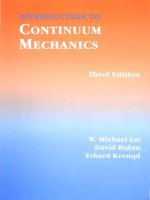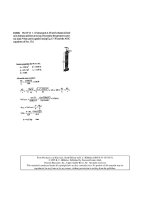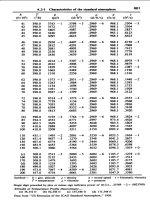Introduction to Continuum Mechanics 3 Episode 8 pps
Bạn đang xem bản rút gọn của tài liệu. Xem và tải ngay bản đầy đủ của tài liệu tại đây (1.05 MB, 40 trang )
266
Torsion
of a
Noncircular Cylinder
Fig.
5.12
5.14
Torsion
of a
Noncircular
Cylinder
For
cross-sections other than circular,
the
simple displacement
field
of
Section
5.13
will
not
satisfy
the
tractionless
lateral
surface
boundary condition (see Example
5.13.4).
We
will show
that
in
order
to
satisfy
this boundary condition,
the
cross-sections
will
not
remain plane.
We
begin
by
assuming
a
displacement
field
that still rotates each
cross-section
by a
small
angle
0,
but in
addition there
may be a
displacement
in the
axial
direction. This warping
of
the
cross-sectional plane
will
be
defined
by
u\
-
(pfa,
x$).
Our
displacement
field now has
the
form
The
associated nonzero strains
and
stresses
are
given
by
The
second
and
third equilibrium equations
are
still satisfied
if
0'
=
constant. However,
the
first
equilibrium equation requires that
Therefore,
the
displacement
field of Eq.
(5.14.1)
will
generate
a
possible state
of
stress
if
<p
satisfies
Eq.
(5.14.3). Now,
we
compute
the
traction
on the
lateral
surface.
Since
the bar is
The
Elastic
Solid
26?
cylindrical,
the
unit normal
to the
lateral surface
has the
form
n
=
n^i
+
n^
and the
associated surface traction
is
given
by
We
require
that
the
lateral surface
be
traction-free, i.e.,
t = 0, so
that
on the
boundary
the
function
<p
must
satisfy
the
condition
Equations(5.14.3)
and
(5.14.4)
define
a
well-known boundary-value
problem
which
is
known
to
admit
an
exact solution
for the
function
(p.
Here,
we
will only
consider
the
torsion
of
an
elliptic
cross-section
by
demonstrating that
gives
the
correct
solution.
Taking
A as a
constant,
this choice
of
<p
obviously
satisfy
the
equilibrium
equation
[Eq.
(5.14.3)].
To
check
the
boundary condition
we
begin
by
defining
the
elliptic boundary
by the
equation
The
unit normal vector
is
given
by
and
the
boundary condition
of Eq.
(5.14.4)
becomes
Substituting
our
choice
of
<p
into this equation,
we
find
that
f It
is
known
as a
Neumann problem
268
Torsion
of a
Noncircular
Cylinder
Because
A
does turn
out to be a
constant,
we
have satisfied both
Eq.
(5.14.3)
and
(5.14.4).
Substituting
the
value
of
<p
into
Eq.
(5.14.2),
we
obtain
the
associated stresses
This distribution
of
stress gives
a
surface traction
on the end
face,
xi
=
I
and the
following
resultant
force
system
Denoting
Mj
=
M
t
and
recalling that
for an
ellipse
733
=
n
a
b/4
and
Iii
—
n
b
a/4,
we
obtain
Similarly
the
resultant
on the
other
end
face
x\
—
0
will
give rise
to a
counterbalancing
couple.
In
terms
of the
twisting moment,
the
stress tensor becomes
The
Elastic
Solid
269
Example
5.14.1
For an
elliptic cylindrical
bar in
torsion,
(a)
find
the
magnitude
of the
maximum
normal
and
shearing stress
at any
point
of the
bar,
and (b)
find
the
ratio
of the
maximum
shearing stresses
at the
extremities
of the
elliptic minor
and
major
axes.
Solution.
As in
Example
5.13.1,
we
first
solve
the
characteristic equation
The
principal values
are
which
determines
the
maximum
normal
and
shearing stresses:
(b)
Supposing that
b
>a,
we
have
at the end of the
minor
axis
(x%
- a,
*3
= 0),
and
at the end of
major
axis
fa =
0,
x$
= b )
The
ratio
of the
maximum
stresses
is
therefore
b/a and the
greater
stress
occurs
at the end of
the
minor axis.
5.15
Pure
Bending
of a
Beam
A
beam
is
a
bar
acted
on by
forces
or
couples
in an
axial
plane, which
chiefly
cause bending
of
the
bar. When
a
beam
or
portion
of a
beam
is
acted
on by end
couples only,
it is
said
to be
in
pure
bending
or
simple
bending.
We
shall
consider
the
case
of
cylindrical
bar
of
arbitrary
cross-section
that
is in
pure bending.
Figure
5.13
shows
a bar of
uniform
cross-section.
We
choose
the*i
axis
to
pass
through
the
cross-sectional centroids
and let
jcj
= 0
andjcj
= /
correspond
to the
left-
and
right-hand
faces
of
the
bar.
270
Pure Bending
of a
Beam
For the
pure bending problem,
we
seek
the
state
of
stress that corresponds
to a
tractionless
lateral surface
and
some distribution
of
normal surface tractions
on the end
faces that
is
statically
equivalent
to
bending couples
M^
=
M^&2
+
^3
e
3
and
M£
=
-M/j
(note that
the
MI
component
is
absent because
MI
is a
twisting couple
).
Guided
by the
state
of
stress
associated
with
simple extension,
we
tentatively assume that
TU is the
only nonzero stress
component
and
that
it is an
arbitrary
function
of
x\.
Fig. 5.13
To
satisfy
equilibrium,
we
require
i.e.,
TU
=
TU
(X2,x$).
The
corresponding strains
are
Since
we
have begun with
an
assumption
on the
state
of
stress,
we
must check whether
these
strains
are
compatible.
Substituting
the
strains into
the
compatibility
equations
[Eq.
(3.16.7-
12)
we
obtain
which
can be
satisfied only
if TU is at
most
a
linear
function
of the
form
The
Elastic
Solid
271
Now
that
we
have
a
possible stress distribution,
let us
consider
the
nature
of the
boundary
tractions.
As is the
case with simple extension,
the
lateral surface
is
obviously traction-free.
On the end
face
xj
=
/,
we
have
a
surface traction
which
gives
a
resultant
force
system
where
A is the
cross-sectional area,
/22,
^33,
and
/23
are the
moments
and
product
of
inertia
of
the
cross-sectional area.
On the
face*i
= 0, the
resultant force system
is
equal
and
opposite
to
that given above.
we
will
set a - 0 to
make
RI
= 0 so
that there
is no
axial forces acting
at the end
faces.
We now
assume, without
any
loss
in
generality, that
we
have chosen
the
*2
and
x^
axis
to
coincide with
the
principal axes
of the
cross-sectional area
(e.g.,
along
lines
of
symmetry)
so
that
/23
= 0. In
this
case,
from
Eqs.
(ix)
and
(x),
we
have
ft =
-M-$/Iy$
and
y
-
M2//22
so
that
the
stress distribution
for the
cylindrical
bar is
given
by
and all
other
TJJ
= 0.
To
investigate
the
nature
of the
deformation that
is
induced
by
bending moments,
for
simplicity
we let
M
3
= 0. The
corresponding strains
are
These
equations
can be
integrated
(we are
assured that this
is
possible since
the
strains
are
compatible)
to
give
the
following
displacement
field:
272
Pure Bending
of a
Beam
where
a/
are
constants
of
integration.
In
fact,
a
4
,
a
5
,
a
6
define
an
overall rigid body
translation
of the bar and
a\,
a-i,
a^
being constant parts
of the
antisymmetric part
of the
displacement gradient,
define
an
overall small rigid body rotation.
For
convenience,
we let all
the
a,-
= 0 [
note
that this
corresponds
to
requiring
u
= 0 and
(Vw^
= 0 at the
origin
]. The
displacements
are
therefore,
Considering
the
cross-sectional
plane
x\
-
constant,
we
note that
the
displacement perpen-
dicular
to the
plane
is
given
by
Since
u\
is a
linear
function
of
x$,
the
cross-sectional plane remains plane
and is
rotated
about
the*2
axis
(see Fig. 5.14)
by an
angle
In
addition, consider
the
displacement
of the
material that
is
initially along
the x\
axis
Cr
2
=.T3
= 0)
The
displacement
of
this material element
(often
called
the
neutral axis
or
neutral
fiber) is
frequently
used
to
define
the
deflection
of the
beam. Note that since
The
Elastic
Solid
273
the
cross-sectional planes remain perpendicular
to the
neutral
axis.
This
is a
result
of the
absence
of
shearing stress
in
pure bending.
Fig.
5.14
Example
5.15.1
Figure
5.15
shows
the right end
face
of a
rectangular
beam
of
width
15
cm
and
height
20
cm.
The
beam
is
subjected
to
pure bending couples
at its
ends.
The
right-hand couple
is
given
as
M
=
700QC2
Nm.
Find
the
greatest normal
and
shearing stresses throughout
the
beam.
Solution.
We
have
and
the
remaining stress components
vanish.
Therefore,
at any
point
and
274
Pure
Bending
of a
Beam
Fig.
5.15
The
greatest value
will
be at the
boundary, i.e.,
x$
=
10"
m.
To
obtain
a
numerical answe
we
have
and
the
greatest stresses
are
Example
5.15.2
For the
beam
of
Example
5.15.1,
if the
right
end
couple
is
M =
7000
(62
+
C3)Nm
and the
left
end
couple
is
equal
and
opposite,
find
the
maximum
normal stress.
Solution.
We
have
The
maximum
normal
stress
occurs
at-x/j
=
-7.5x
10
2
m and
x$
= 10
1
m
with
The
Elastic
Solid
275
5.16
Plane
Strain
If
the
deformation
of a
cylindrical body
is
such
that there
is no
axial components
of the
displacement
and
that
the
other components
do not
depend
on the
axial coordinate, then
the
body
is
said
to be in a
state
of
plane strain. Such
a
state
of
strain exists
for
example
in a
cylindrical
body whose
end
faces
are
prevented
from
moving
axially
and
whose lateral surface
are
acted
on by
loads that
are
independent
of the
axial
position
and
without axial components.
Letting
the
63
direction correspond
to the
cylindrical
axis,
we
have
The
strain components corresponding
to
this displacement
field
are:
and
the
nonzero stress components
are
TU
,
7\2,
722,
^33,
where
This last equation
is
obtained
from
the
Hooke's law,
Eq.
(5.4.8c)
and the
fact
that
£"33
= 0 for
the
plane strain problem.
Considering
a
static stress
field
with
no
body
forces,
the
equilibrium equations reduce
to
Because
733
=
T^
(xi,
KI
), the
third
equation
is
trivially
satisfied.
It can be
easily
verified
that
for any
arbitrary scalar
function
<p,
if
we
compute
the
stress components
from
the
following
equations
then
the first two
equations
are
automatically
satisfied.
However,
not all
stress components
obtained this
way are
acceptable
as a
possible solution because
the
strain components derived
from
them
may not be
compatible; that
is,
there
may not
exist
displacement
components
which
276
Plane
Strain
correspond
to the
strain
components.
To
ensure
the
compatibility
of the
strain
components,
we
obtain
the
strain components
in
terms
of
<p
from
Hooke's
law
Eqs.
(5.4.8)
[and using
Eq.
(5.163)]
•**
^
and
substitute them into
the
compatibility equations, Eqs.
(3.16.7)
to
(3.16.12).
For
plane
strain problems,
the
only compatibility equation that
is not
automatically satisfied
is
Thus,
we
obtain
the
following
equation governing
the
scalar
function
<p:
i.e.,
Any
function
<p
which satisfies
Eq.
(5.16.8)
generates
a
possible elastic solution.
In
par-
ticular,
any
third
degree
polynomial (generating
a
linear stress
and
strain
field)
may be
utilized.
The
stress
function
<p
defined
by
Eqs. (5.16.5)
and
satisfying
Eq.
(5.16.8),
is
called
the
Airy
Stress
Function.
We
can
also
obtain
from
the
Hooke's
law
[Eq.
(5.16.6)],
the
compatibility equation
[Eq.
(5.16.7)]
and the
equations
of
equilibrium
[Eqs.
(5.16.4)]
the
following
:
[See
Prob.
5.77]
which
may
also
be
written
as
The
Elastic
Solid
277
where
Example
5.16.1
Consider
the
Airy
stress
function
(a)
Obtain
the
stresses
for the
state
of
plane strain;
(b) If the
stresses
of
part(a)
are
those inside
a
rectangular
bar
bounded
by
x\
=
0,
jcj
=
/,
jn/2
=
±(h/2)
and
£3
=
±(6/2),
find
the
surface
tractions
on the
boundaries
(c) If the
boundary
surfaces
*3
= ±
(b/2)
are
traction-free,
find
the
solution.
Solution,
(a)
From
Eq.
(5.16.5)
that
is,
We
note that
the
surface normal stress
on the
side faces
x$
=
±(£/2)are
required
to
prevent
them
from
moving
in
thex^
direction.
(c)
In
order
to
obtain
the
solution
for the
case where
the
side
facesx^
=
±(b/2)
are
traction
-free
(and therefore have
non
zero
1/3),
it is
necessary
to
remove
the
normal stresses
from
these
side faces.
Let us
consider
the
following
state
of
stress
278
Plane
Strain
This state
of
stress
is
obviously
a
possible state
of
stress because
it
clearly satisfies
the
equations
of
equilibrium
in the
absence
of
body
forces
and the
stress components, being linear
in
$2,
&
VQ
rise
to
strain components that
are
also linear
in.*^
so
that
the
compatibility conditions
are
also
satisfied.
Superposing this state
of
stress
to
that
of
part
(a),
that
is,
adding
Eq.
(iic)
and Eq.
(iv)
we
obtain
We
note that this
is the
exact solution
for
pure bending
of the bar
with
couple vectors parallel
to the
direction
of
63.
In
this example,
we
have easily obtained,
from
the
plane strain solution where
the
side faces
x
3
= ±
(b/2)
of the
rectangular
bar are
prevented
from
moving normally,
the
state
of
stress
for
the
same rectangular
bar
where
the
side
faces
are
traction-free,
by
simply removing
the
component
T$$
of the
plane strain solution. This
is
possible
for
this problem
because
the
T^
obtained
in the
plane strain solution
of
part
(a)
happens
to be a
linear
function
of the
coordinates.
Example
5.16.2
Consider
the
state
of
stress given
by
Show
that
the
most general
form
of
G(x\,
KI
)
which
gives rise
to a
possible state
of
stress
in
the
absence
of
body
force
is
Solution.
The
strain components
are
The
Elastic
Solid
279
From
the
compatibility equations, Eqs. (3.16.8), (3.16.9)
and
(3.16.7),
we
have
Thus,
G(XI
£1)
= a
K\
+
J3x2
+
y.
In the
absence
of
body
forces,
the
equations
of
equilibrium
are
obviously satisfied.
Example
5.16.3
Consider
the
stress
function
<p
= a
xi
^
+ fi
xi
KI
(a) Is
this
an
allowable stress function?
(b)
Determine
the
associated stresses
for the
plane strain case.
(c)
Determine
a and ft in
order
to
solve
the
plane strain problem
of a
cantilever beam with
end
load
P
(Fig.
5.16).
Fig.
5.16
(d) If the
faces
x$
=
±b/2
are
traction-free,
are the
stress components given
in (b)
still valid
for
this
case
if we
simply remove
733
from
them
?
Solution,
(a)
Yes,
because
the
stress
function
satisfies
Eq.
(5.16.8) exactly.
280
Plane Strain
(b)
The
stress components
are
i.e.,
for the
plane strain problem
(c)
On the
boundaries,
KI
-
±h/2,
the
tractions
are
But,
we
wish
the
lateral
surface
fa -
±h/2)
to be
traction-free, therefore
On
the
boundary*!
= 0,
This shearing traction
can be
made equipollent
to an
applied load
P*2
by
setting
where
A =
bh
and / = b
h?/l2.
Substituting
for
ft, we
have
Therefore,
a =
2P/bh
3
'fi
=
-3P/2bh
and the
stresses
are
In
order that
the
state
of
plane strain
is
achieved,
it is
necessary
to
have normal tractions
acting
on the
side faces
x-$
=
±6/2.
The
tractions
are in
fact
t = ±
^363
=
±6
v a
x.\
X2
^
(d)
Since
Ty$
is not a
linear
function
of the
coordinates
jcj
and
*2,
from example
5.16.2,
we
see
that
we
cannot simply remove
r
33
from
the
plane strain solution
to
arrive
at a the
stress
The
Elastic
Solid
281
state
for the
beam where
the
side
faces
x$
=
±b/2
are
traction free. However,
if b is
very
very
small,
then
it
seems reasonable
to
expect
that
the
application
of
-Ti$
on
these side
face
alone
will
result
in a
state
of
stress inside
the
body
which
is
essentially given
by
(Indeed
it
can
be
proved that
the
errors incurred
in
this
equation approach zero with
the
second
power
of b as b
approaches zero). Thus,
the
state
of
stress obtained
in
part
(b),
with
733
taken
to be
zero,
is the
state
of
stress inside
a
thin beam under
the
same external loading
as
that
in
the
plane strain case. Such
a
state
of
stress
is
known
as the
state
of
plane
stress
where
the
stress
matrix
given
by
The
strain field corresponding
to the
plane stress state
is
given
by
5.17 Plane Strain Problem
in
Polar Coordinates
In
Polar
coordinates,
the
strain components
in
plane strain problem
are,
[with
T
a
=
v(Tr+Tw)],
The
equations
of
equilibrium
are
[see Eqs.
(4.8.1)],
(noting that there
is
no
z
dependence).
282
Plane
Strain
The
third equation
is
automatically
satisfied,
because
T
z
$
-
T
n
- 0 and
T
zz
is not a
function
of
z.
It can be
easily
verified
that
the
equations
of
equilibrium
Eq.
(5.17.2a)
are
identically
satisfied
if
where
<p
is the
Airy
stress
function.
In
Section 5.16,
we see
that
in
order
to
satisfy
the
compatibility conditions,
the
Cartesian stress components
TU
+
T^i
must
satisfy
Eq.
(5.16.9),
i.e.,
To
derive
the
equivalent expression
in
cylindrical coordinates,
we
note that
TU
+ 722
*
s
tne
first
scalar invariant
of the
stress tensor. Therefore
Also,
the
Laplacian
operator
V
2
=
(d
2
/drf
+
d
2
/At§
)
takes
the
following
form
in
polar
coordinates
Thus,
the
function
<p
must
satisfy
the
biharmonic equation
If
<p
is a
function
of
r
only,
we
have,
The
Elastic
Solid
283
and
The
general solution
of
this
equation
is
[See Prob. 5.78]
The
stress
field
corresponding
to
this
stress
function
is
and
the
strain components are:
the
displacement
components
can be
obtained
by
integrating
the
above equations. They
are
[See
Prob.
5.79],
(ignoring
the
terms that
represent
rigid body displacements)
284
Thick-walled Circular Cylinder under
Internal
and
External
Pressure
5.18 Thick-walled Circular
Cylinder
under
internal
and
External Pressure
Consider
a
circular cylinder subjected
to the
action
of an
internal
pressure
p/
and an
external
pressure
p
0
.
The
boundary conditions
for the
plane strain problem are:
These boundary conditions
can be
easily
shown
to be
satisfied
by the
following
stress
field
These
components
of
stress
are
taken
from
Eq.
(5.17.10)
with
B = 0 and
represent
therefore,
a
possible state
of
stress
for the
plane strain problem, where
T^
=
v
(T^
+
TQQ).
We
note that
4Br6
2
if
B is not
taken
to be
zero, then
ua
=
—=—
(1
-v )
which
is not
acceptable because
if we
start
by
from
a
point
at 6
=0,
trace
a
circuit around
the
origin
and
return
to the
same point,
0
becomes
2jt
and the
displacement
at the
point takes
on a
different
value.
Now
applying
the
boundary
conditions given
in
Eqs. (5.18.1),
we
find
that
We
note that
if
only
the
internal pressure
/>/
is
acting,
T
n
is
always
a
compressive stress
and
TQQ
is
always
a
tensile stress.
The
above
stress
components together with
T
zz
=
v
(7^
+
TQQ)
constitute
the
exact plane
strain
solution
for the
cylinder whose
axial
end
faces
are
fixed.
As
discussed
in the
last section,
the
state
of
stress given
by
Eqs.
(5.18.3)
above
and
with
TZZ
=
0»
can
a
^
so
b®
regarded
as an
approximation
to the
problem
of a
cylinder which
is
very
thin
in the
axial direction, under
the
action
of
internal
and
external pressure
with
traction-free
end
faces. However,
the
strain
field
is not
given
by Eq.
(5.17.11),
which
is for the
plane strain
case.
For the
plane stress case,
The
Elastic
Solid
285
Example
5.18.1
Consider
a
thick-wall cylinder subjected
to the
action
of
external
pressure
p
0
only.
If the
outer radius
is
much much larger than
the
inner radius. What
is the
stress field?
Solution.
From Eqs. (5.18.3),
we
have
When
b is
much much larger than
a,
these become
5.19
Pure
Bending
of a
Curved
Beam
Fig. 5.17 shows
a
curved beam whose boundary surfaces
are
given
by r
=
a,r
=
b,
0 =
±a
and z =
±h/2.
The
boundary surface
r = a
,r
- b and z
—
±h/2
are
traction-free.
Assuming
the
dimension
h is
very small compared with
the
other
dimensions.,
we
wish
to
obtain
a
plane stress solution
for
this curved beam under
the
action
of
equal
and
opposite bending
couples acting
on the
faces
6
=
±a.
286
Pure
Bending
of a
Curved Beam
Fig.
5.17
In
the
following
we
shall show that
the
state
of
stresses
given
in
Eqs.
(5.17.10)
together
with
T
zz
= 0 can be
used
to
give
the
desired solution.
The
stress
components are:
Since
the
surfaces
r
=
a and r = b are
traction-free,
the
constants
yl,
B and C
must
satisfy
On the
face
0
=
a,
there
is a
distribution
of
normal stress
TQQ
given
by Eq.
(5.19.1b
). Let us
compute
the
resultant
of
this distribution
of the
normal
stresses:
In
view
of
Eqs.
(5.19.2),
we
have
The
Elastic
Solid
287
That
is, the
resultant
of
the
distribution
of
normal stresses must
be a
couple.
Let
the
moment
of
this
couple
per
unit
width
be M as
shown
in
Fig.
5.17,
then
i.e.,
In
view
of
Eqs.
(5.19.2),
Eq.
(5.19.4)
can
also
be
written
as
[see Prob. 5.80]
Equations
(5.19.2a)
(5.19.2b)
and
(5.19.4)
are
three equations
for the
three
constants
A,B
and
C. We
obtain,
where
Thus
5.20 Stress
Concentration
due to a
Small Circular Hole
in a
Plate under
Tension
Fig. 5.18 shows
a
plate
with
a
small circular hole
of
radius
a
subjected
to the
actions
of
uniform
tensile stress
of
magnitude
a on the
faces
perpendicular
to the x
direction.
Let us
288
Stress
Concentration
due to a
Smalt
Circular
Hole
in a
Plate
under
Tension
consider
the
region between
two
concentric circles:
r = a and r =
b.
The
surface
r = a is
traction-free,
i.e.,
Fig.
5.18
If
b is
much larger than
a,
then
the
effect
of the
small hole
will
be
negligible
on
points lying
on
the
surface
r = b so
that
the
state
of
stress
at r = b as
a/b~*Q
will
be
that
due to the
uniaxial
tensile stress
a in the
absence
of the
hole.
In
Cartesian coordinates, this state
of
stress
is
TH
=
o
with
all
other stress components zero.
In
cylindrical
coordinates
this
same state
of
stress
has the
following
nonzero stress components
Thus,
the
stress vector acting
on the
surface
r = b has the
r-component
and
Q—component
given
by
and
Therefore,
the
solution
to the
problem
at
hand
can be
obtained
as
follows: Find
the
elastos-
tatically
possible equilibrium plane stress
field
which
satisfies
the
boundary conditions:
(i) at
The
Elastic
Solid
289
First,
we
shall demonstrate that
the
stress
field
generated
from
the
Airy
stress
function
in
the
form
of
<p
=
f(r)
cos 2 6, can be
used
to
give
a
stress
field
which
satisfies
the
boundary
conditions
Then,
to
this stress
field,
we
will
superpose
the
stress
field
which
is the
solution
for a
hollow cylinder
with
a
very
thick
wall
(i.e.,6/a-»<»),
acted
on by a
uniform
radial traction
—
on the
outer surface
r-b
only
[see Eqs.
(5.18.5)
in
Example
5.18.1],
In
this way,
the
boundary conditions Eqs. (5.20.2)
can be
satisfied-
Substituting
into
the
equation
governing
the
Airy's
stress
function,
Eq.
(5.17.6), i.e.,
we
obtain that
the
function
f(r) must
satisfy
the
following
equation
The
general solution
for
this
equation
is
[see Prob. 5.81]
Thus,
and
the
corresponding stress components
are
[see Eqs.
(5.17.3)]
290
Stress
Concentration
due to a
Small
Circular
Hole
in a
Plate under Tension
Using
Eqs. (5.20.9),
the
boundary conditions (5.20.3) become
As
&-»•<»
, Eq.
(5.20.10a) becomes
2A =
, so
that
A
=
, Eq.
(5.20.10b) becomes
6B
b
2
= 0 so
thatB
=
0 and
Eqs.
(5.20.10
c) and (d)
become
Thus,
Substituting these values into Eqs. (5.20.9)
and
superpose them onto
the
stress
field
given
in
Eq.
(5.20.4),
we
obtain









